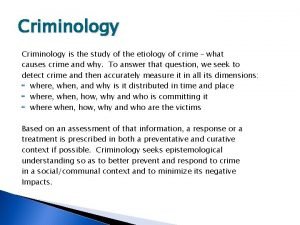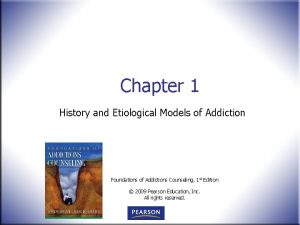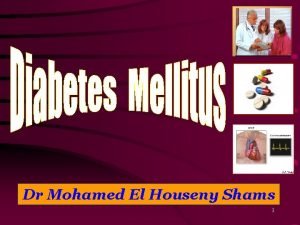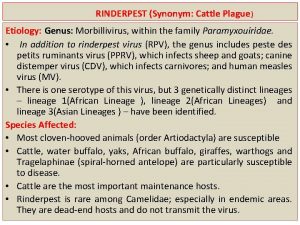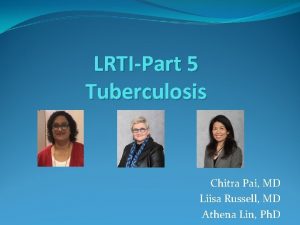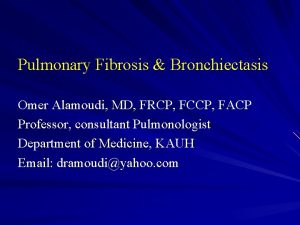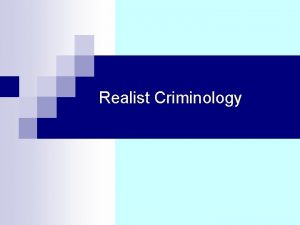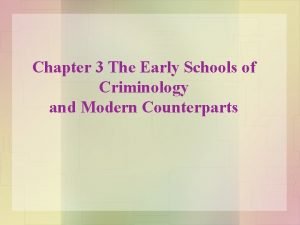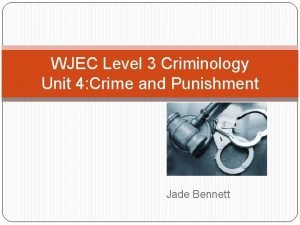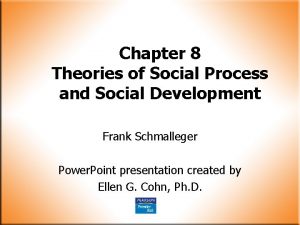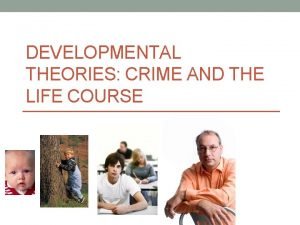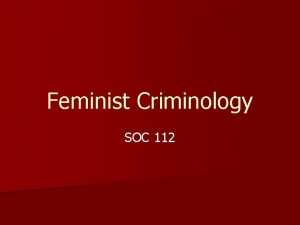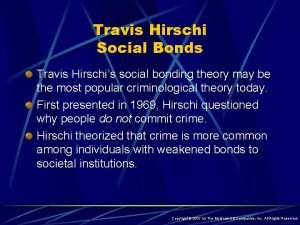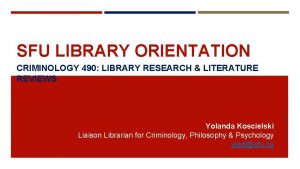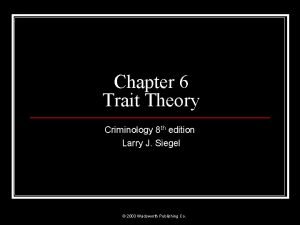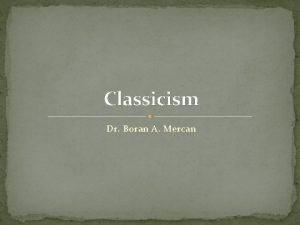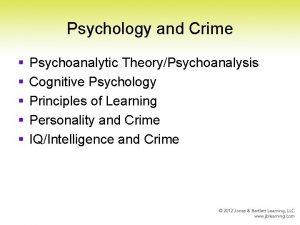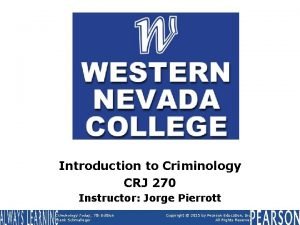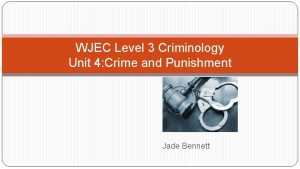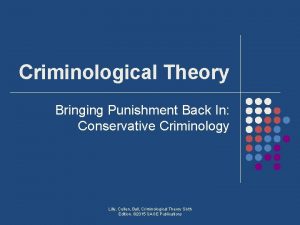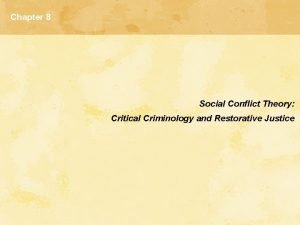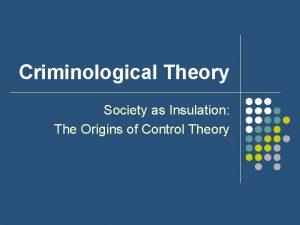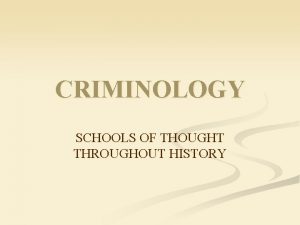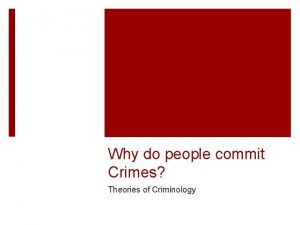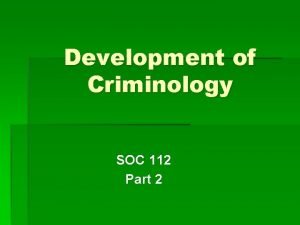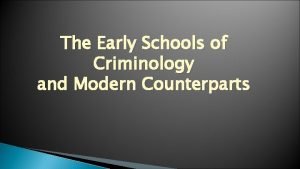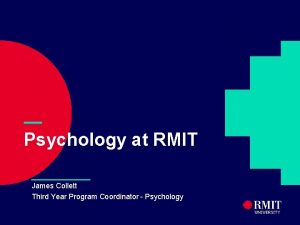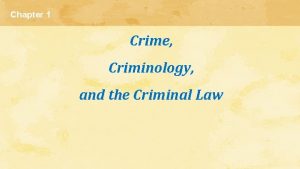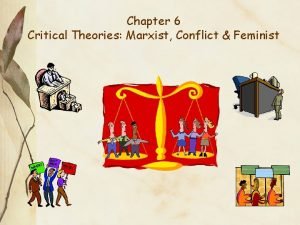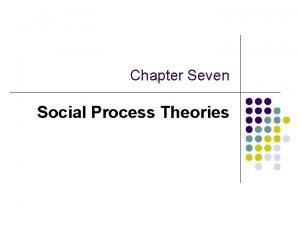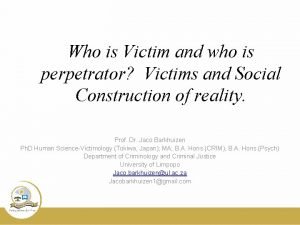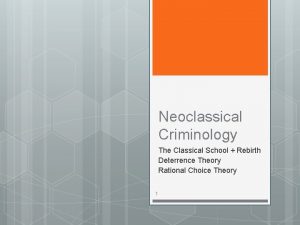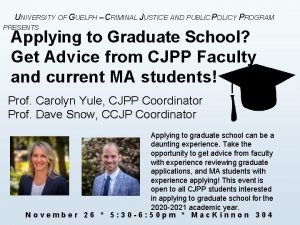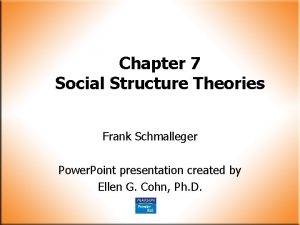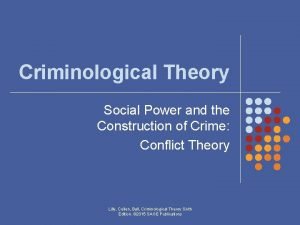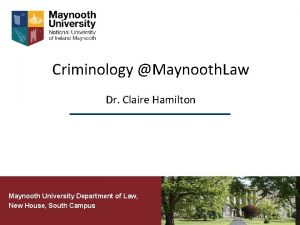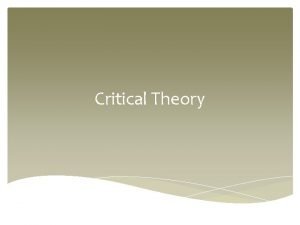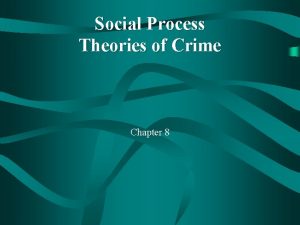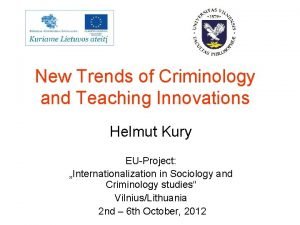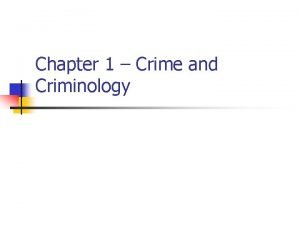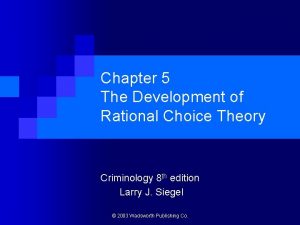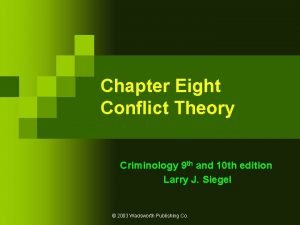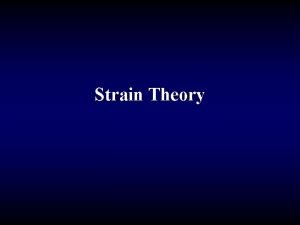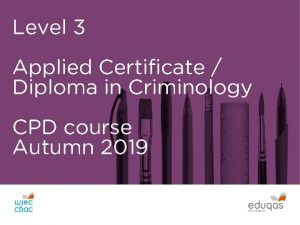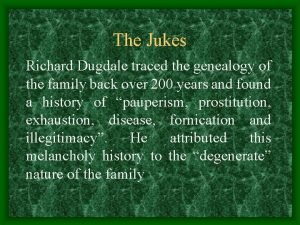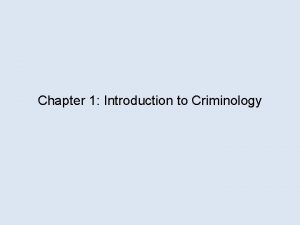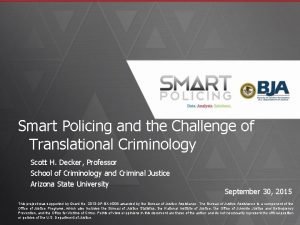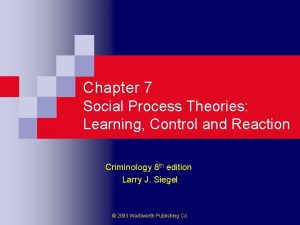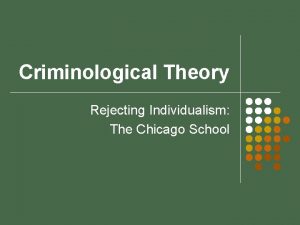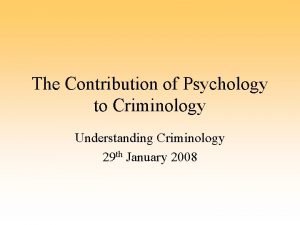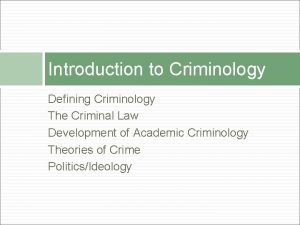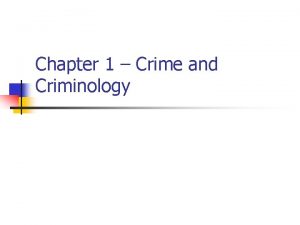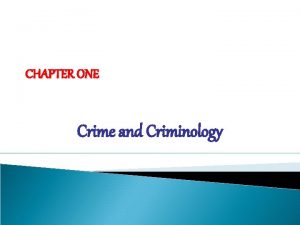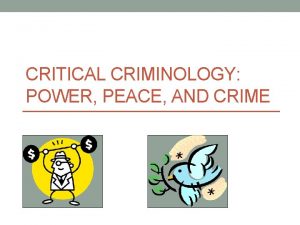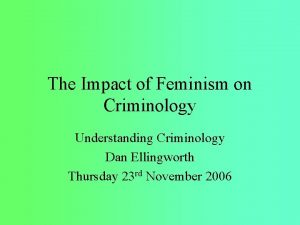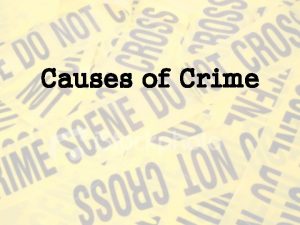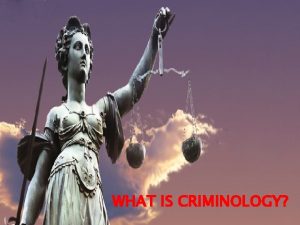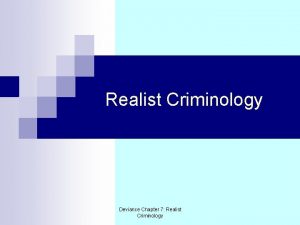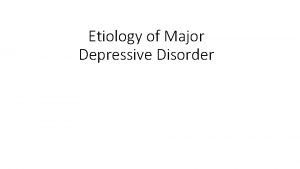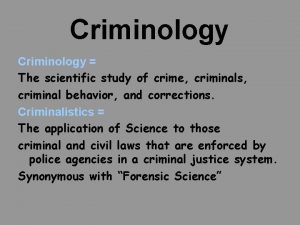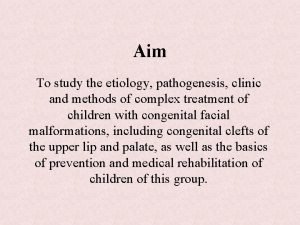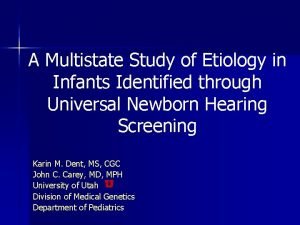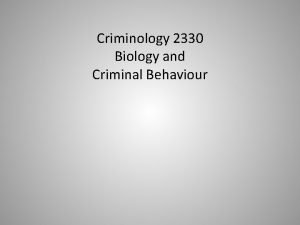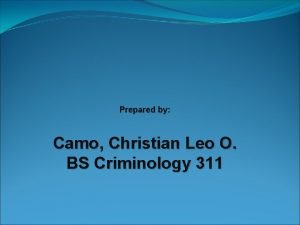Criminology is the study of the etiology of































































































- Slides: 95

Criminology is the study of the etiology of crime – what causes crime and why. To answer that question, we seek to detect crime and then accurately measure it in all its dimensions: where, when, and why is it distributed in time and place where, when, how, why and who is committing it where when, how, why and who are the victims Based on an assessment of that information, a response or a treatment is prescribed in both a preventative and curative context if possible. Criminology seeks epistemological understanding so as to better prevent and respond to crime in a social/communal context and to minimize its negative Impacts.

Criminology: Preliminary Thoughts Macro differentiation/inter crime specificity Micro differentiation/intra crime specificity We overuse the word “cause”: a. causality v. spurious correlations b. causality v. accentuating, aggravating impacts

Criminology: Preliminary Thoughts Micro responses - Criminology assumes the medical model (discover the problem, assess its nature and extent, prescribe a response/a cure), but it falls short because: 1. There are no accurate diagnostic instruments (no criminological thermometers, no criminological x-rays or CAT scans) 2. No body of diagnostic knowledge 3. No evidence-based, generally consistent, uniformly applicable and effective treatment modalities Macro responses (risk factors; protective factors)

Type 1 (Alpha Error) It is impossible to speak of one specific cause for the wide range of behavior classified as criminal ◦ Macro ◦ Micro

Type II (Beta Error) You cannot call something a cause of an event if it rarely produces the event. Many factors impact in a non-causal context, and would more appropriately be called: Contributing factors Precipitating factors Accentuating factors Aggravating factors Compounding factors

Type III Error Criminology, like medicine, assumes conformity and seeks to explain deviance. Perhaps we should assume deviance and explain conformity. - Why do nearly all people, nearly all the time, refrain from crime? - What is the cause of virtue? - How does society build a citizenry of character?

Kohlberg Typology Level 1 – Fear of Punishment Level 2 – Promise of Reward Level 3 – Altruistic Motivation Justice will be realized only when people are intrinsically willing to obey the unenforceable.

Scientific Criminology An interdisciplinary social science-based field of study that seeks a core, etiological understanding of the preventative and curative aspects of crime that seeks to develop and continually enhance a body of scientific knowledge relative to preventative and curative strategies; the seeks to create better measurement instruments, better diagnostic capabilities, and ultimately, better preventative, control and treatment options.

Public Criminology Science in general is constrained due to deep rooted social, economic, and political factors. There are scientific truths and there are political truths. In the end, political “leaders” look not to science, but to the political palatability coefficient, to the political truths, to survive. So rather than criticize, we need to recognize that this is simply the nature of the job, and we need to adjust accordingly.

Role of Criminologists and justice professionals must: * Uncover scientific truths/grow the body of knowledge. * Be alert as to when the best time would be to bring the results forward (be attuned to the zeitgeist). *Engage in activities that create a politically palatable environment/create a setting where truths can be aired and implemented. We must be both scientific and public criminologists for our research to have any value.

Theories of Deviance I. ) Demonological Theories 1. ) Traditional ‑ Augustine, Gregory I, Gregory VII, Jerome 2. ) Pre‑Classical ‑ Aquinas, Luther, Machiavelli 3. ) Social Contract ‑ Hobbes, Locke, Rousseau, Voltaire

Theories of Deviance I. ) Demonological Theories A. ) Traditional ‑ Augustine, Gregory I, Gregory VII, Jerome Behavior is caused by other world factors – sin, Satan, trial by ordeal, will of God, predestination, people basically bad, church punishes, frequent and harsh punishments B. ) Pre‑Classical ‑ Aquinas, Luther, Machiavelli The Pre-Classical writers press the margin per the above principles, some things are not sin (mala in se) but wrong from a civic context (mala prohibitum), some acts punished by the State

Theories of Deviance I. ) Demonological Theories…continued C. ) Social Contract ‑ Hobbes, Locke, Rousseau, Voltaire Behavior a mix of other world factors and by personal impulses and instincts, you agree to abide by the laws and the State agrees to maintain order, the State punishes when that contract is violated Hobbes – people are basically bad, the reason there is crime is because the state does not punish with sufficient frequency and severity Locke, Rousseau, Voltaire – people are basically good (new paradigm), head of the state is the servant of the people, rule of law (no one, not even the King is above the law), it is better to free a guilty man than to condemn an innocent one Hobbes wins out initially, but Lockean et al philosophies eventually emerge in the Western world

Theories of Deviance I. ) Demonological Theories 1. ) Traditional ‑ Augustine, Gregory I, Gregory VII, Jerome 2. ) Pre‑Classical ‑ Aquinas, Luther, Machiavelli 3. ) Social Contract ‑ Hobbes, Locke, Rousseau, Voltaire II. ) Naturalistic Theories 1. ) Classical ‑ Cicero, Beccaria, Bentham, Burke

Classical Theory There is crime because the state lacks certainty and severity in its punishment delivery systems, and it is the state’s job to punish, not the church. To stop crime, we need more police, prosecutors, and prisons. Punish lots of people, punish them regularly and harshly. Classical theory is based on deterrence theory. Crime is to be prevented through fear of receiving sanctions (Rational Man Theory). The state needs to make the costs of engaging in crime higher than the benefits, and communicate that to the public.

Classical Theory There are some aggregate costs (innocent punished/guilty punished more severely than they should be – read Liberty v. Order), but these costs are the necessary and totally acceptable secondary collateral consequences as we must avert chaos and maintain order and stability as the primary/overriding goal.

Classical Theory 1. People are basically evil 2. Self determinism 3. Order the over-riding focus; liberty is but a secondary concern 4. Deterrence Theory/Rational Man Theory 5. Focus on the crime 6. State punishes (not the church) 7. Utilitarian perspective

General Deterrence Theory Specific vs. General Swiftness Certainty Severity Clarity Severity is not a substitute for certainty. Certainty is the key element.

Classical Theory This was the prominent theory from the mid-1700 s until the late 1800 s. The Kings loved it for it justified their harsh and arbitrary use of power, as did another holdover notion from the Demonological era, the Divine Right of Kings. There ideas taken in tandem justified the Kings’ punitive ways, and loved Bentham for justifying their murders and frauds. Under Demonological theory, the Pope was the judge. Under Classical theory (and its Divine Right of Kings notion), the Kings were the ultimate judge. Under Positivism (our next topic), it is the people who rule and reign (popular sovereignty), and there are many perspectives that have grown from this orientation.

Theories of Deviance I. ) Demonological Theories 1. ) Traditional ‑ Augustine, Gregory I, Gregory VII, Jerome 2. ) Pre‑Classical ‑ Aquinas, Luther, Machiavelli 3. ) Social Contract ‑ Hobbes, Locke, Rousseau, Voltaire II. ) Naturalistic Theories 1. ) Classical ‑ Cicero, Beccaria, Bentham, Burke 2. ) Positivist ‑ Lombroso, Quetelet, Comte A. Biological Determinism ‑ Galton, Lombroso 1. Constitutional ‑ Gall, Goring, Hooton, Jacobs, Sheldon 2. Bio Social ‑ Hippchen, Jeffrey, Edward O. Wilson

Positivist Theory Classical theory slowly slipped underground with the success of the industrial revolution and the emergence of a middle class who no longer accepted the harsh and arbitrary use of power by Kings. In the place of Classical theory came a new paradigm, a new school of thought called Positivism that also interestingly grew out of the Social Contract paradigm, stealing not from Hobbes of course as Classical theory did, but from Voltaire, Locke and Rousseau and is based on the notion that people are basically good – positivism.

Positivist Theory 1. People are basically good. 2. The king is the servant of the people 3. The rule of law is dominant, and no one is above the law (not even the king) 4. Rules and regulations are in place to regulate the power of the Kings/the Regents/the elites 5. Power to the people/popular sovereignty 6. Liberty, not state controlled order, reigns supreme 7. Evidence-based, data driven orientation

Bio-Criminology There are born criminals with definite physical anomalies, sub-humans who will never change (criminaloids), unless we intervene biologically. We divide this school of thought into two categories: * Constitutional: Crime is due to definitive and identifiable physical abnormalities in people. Criminals are biologically/organically inferior, physically and mentally. * Bio-Social/Bio-Crim: Behavior is a result of bio-chemical imbalances and genetic abnormalities, but also the environment. The focus of the biocriminologists, is on the genetic and bio-chemical.

Bio-Criminology…continued Three areas of focus: ◦ Genetic origins of crime ◦ Internally sourced origins of crime: Enzyme/hormonal imbalances Insufficient brain development/brain abnormalities ◦ Externally sourced origins of crime: Exposure to externally sourced toxic materials General nutrition/vitamin deficiencies (orthomolecular deficiencies)

Bio-Criminology…continued Genetic Origins of Crime: ◦ Violence genes, lying genes, crime genes, morality genes, alcoholism genes, religiosity genes? ◦ Impulsivity and ADHD (attention deficit and hyperactivity disorder) are perhaps 75% genetically based ◦ Variations in the AR gene are associated with violent crime ◦ DNA manipulations ◦ Caspi and Trembly studies

Bio-Criminology…continued Caspi study ◦ abused/insufficient nurturing + genetically vulnerable: 85% developed anti-social behaviors ◦ abused/insufficient nurturing + no genetic vulnerability: virtually no anti-social tendencies ◦ not abused/sufficient nurturing + genetic vulnerability: virtually no anti-social tendencies

Bio-Criminology…continued Behavior Impacted By Genetic Environment 18 months old 82% 18% 60 months old 66% 34% (Trembly thesis is that the 66% figure will drop even further as time passes)

Bio-Criminology…continued Internally Sourced Origins of Crime A. Hormone and enzyme imbalances: Serotonin Dopamine Melatonin Testosterone Estrogen/PMS MAOA Phenethylamine/MAO-B

Bio-Criminology…continued Internally Sourced Origins of Crime: B. Insufficient brain development/brain abnormalities: ◦ Reactive Aggressive Teens: high Amygdala activity and less frontal lobe activity ◦ Pedophiles: lower volume of gray matter in the orbitofrontal cortex, the cerebellum and the ventral striatum ◦ Pedophiles: abnormal serotonin subsystem in the brain ◦ Men v Women: low volume of gray matter in the orbitofrontal cortex is highly correlated with violent and anti-social behaviors; in the aggregate, men have lower volumes than women ◦ Antisocial individuals: damage in the dorsal and ventral prefrontal cortex and angular gyrus

Bio-Criminology…continued B. Insufficient brain development/brain abnormalities …continued: ◦ High norm compliance individuals: high activity in the lateral orbitofrontal cortex and right dorsolateral prefrontal cortex (areas not developed until early 20 s) ◦ Violent offenders: large white matter volume in the occipital, parietal lobes and left cerebellum; large gray matter volume in the right cerebellum ◦ Violent offenders: atrophy in the postcentral gyri, frontopolar cortex and orbiofrontal cortex ◦ Youth Brain Shrinkage: frontal and pre-frontal cortex shrinkage/shrinkage of the risk aversion center of the brain (age 15 – 25) ◦ Violent youth: slower neurological transmission issues ◦ Novelty seeking individuals: fast firing dopamine neurons in the brain ◦ Prenatal alcohol exposure: alters white matter structure in the frontal and occipital lobes

Bio-Criminology…continued Externally Sourced Origins of Crime: A. Exposure to toxic substances: ◦ Heavy metals (lead, cadmium, mercury, PCBs) ◦ HCD (hexachlorobenzene) ◦ Prenatal nicotine exposure

Bio-Criminology…continued Externally Sourced Origins of Crime: B. Nutritional/Orthomolecular Deficiencies ◦ ◦ ◦ ◦ ◦ General vitamin and nutritional deficiencies Prenatal protein deficiencies Cholesterol deficiencies Zinc deficiencies Fatty acid deficiencies (Omega 3, Omega 6, DHA) Iron deficiencies Vitamin B and Chromium deficiencies Hypoglycemia issues (sugar) Insufficient manganese consumption Schoenthaeler study

Bio-Criminology…continued How do we respond? ◦ Eat healthy substances/orthomolecular therapy (take good things in) ◦ Eat substances that will remove the toxic substances from the body (get the bad things out) ◦ Move away from toxic sources (don’t let any more bad things in) ◦ Bio-chemical interventions in serious cases: Ritalin Rebuifin Lithium Galvanic skin implants Metoprolol Depo-Provera/MPA Thorazine

Bio-Criminology Summary Crime is caused by biological imbalances. These imbalances have: ◦ Genetically sourced origins ◦ Internally sourced origins: Enzyme/hormonal imbalances Insufficient brain development/brain abnormalities ◦ Externally sourced origins: Exposure to externally sourced toxic materials General nutrition/vitamin deficiencies (orthomolecular deficiencies) To ◦ ◦ reduce crime, we need to: Put good things in the body Get the bad things out of the body Don’t let anymore bad things in the body Engage in physical interventions and drug therapy in serious cases

Bio-Criminology Problems Ignores the Constitution Ignores Durkheim (society of clones) Ignores Durkheim (faulty intelligence to crime assumption) Alpha error (explains violence, but little else) Extreme potential for abuse Very difficult to implement today There is a future for bio-criminology as there is much empirically valid work being done in this area. Science is proverbially ahead of culture, bio -criminology in particular, so it will take some time for this perspective to be integrated into the mainstream (Max Plank theorem).

Theories of Deviance I. ) Demonological Theories 1. ) Traditional ‑ Augustine, Gregory I, Gregory VII, Jerome 2. ) Pre‑Classical ‑ Aquinas, Luther, Machiavelli 3. ) Social Contract ‑ Hobbes, Locke, Rousseau, Voltaire II. ) Naturalistic Theories 1. ) Classical ‑ Cicero, Beccaria, Bentham, Burke 2. ) Positivist ‑ Lombroso, Quetelet, Comte A. Biological Determinism ‑ Galton, Lombroso 1. Constitutional ‑ Gall, Goring, Hooton, Jacobs, Sheldon 2. Bio Social ‑ Hippchen, Jeffrey, Edward O. Wilson B. Cultural Determinism ‑ Quetelet 1. Psychological ‑ Tarde a. Cognitive Theory ‑ James, Menninger, Piaget b. Freudian Theory/Psychoanalysis ‑ Freud, Jung c. Learning Theory ‑ Bandura, Skinner

Cultural Determinism comes down on the nurture side in the classic nurture vs. nature debate. Acts committed by individuals are the result of social/cultural/environmental experiences. Two general schools of thought – psychological and sociological. Psychological school – Deviant behavior due to individual personality deviations. When the person is psychologically and emotionally balanced they will no longer commit crime. This is an individual-focused orientation.

Psychological School Freudian psychology - Crime is a product of inner psychic conflict. Crime is due to childhood trauma, repressed feelings of anxiety, conflict between the id (pleasure-seeking center) the ego (reality component) and the superego (punishment component). Because of conflict between the id, the ego and the superego, people repress feelings into the realm of unconsciousness, and those feelings surface from time to time in the form of undesirable behavior. The unconscious is a source of conscious motivation, and thus a party of psychotherapy. People are classified as psychotic, neurotic, dissocial, schizophrenic, with inferiority complexes and identity crises, and psychopathic (the classic “criminal” label). All of these mental abnormalities can lead to antisocial behavior.

Psychological School Learning theory – Behavior is learned, often subconsciously, but learned (ie. Pavlov). The world, the environment, shapes people. This theory de-emphasizes the conscience, the id/ego/superego internal conflict notions of Freudian psychology and instead emphasis the principles of positive and negative reinforcement. So change people by rewarding conventional behavior and punishing abnormal/undesirable behavior. Often called Skinnerian psychology, or rat psychology.

Psychological School Cognitive theory – Crime is due to thwarted individual moral development. This theory emphases the individual’s need to take responsibility for their own actions. It is a conscious learning orientation that stresses the need for a deliberate internal conversion to a more responsible lifestyle. As individuals reach moral high ground, they are less inclined to engage in criminal behavior. Behavior should be motivated by altruistic factors Rather than by fear of punishment (Kohlberg typology). Psychology is the quintessential soft science. It is based, not on evidence, but on educated guesswork, tempered with intuition and personal experience. Psychiatric testimony regarding criminal behavior only distorts the fact-finding process (see Margaret Hagen, Whores of the Court). Counterpoint- become a forensic psychologist and advance the field!

Theories of Deviance…continued 2. Sociological ‑ Durkheim, Ferri a. Social Structure Theories ‑ Burgess 1. Culture Conflict ‑ Miller, Sellin 2. Differential Opportunity ‑ Cloward, Ohlin 3. Relative Deprivation ‑ Blau and Blau 4. Social Disorganization ‑ Mc. Kay, Shaw, Thrasher 5. Strain ‑ Agnew, Merton 6. Subculture Conflict ‑ Cohen

Sociological School – Emphasizes the socio-economic impacts on behavior. It has little micro value, but great macro or aggregate value in explaining crime. There are two general theoretical constructs that fall under this orientation - social structural theories and social process theories. Social structural theories – There are several theories that fall under this broad category. They all use as the basis, the fact that we live in socioeconomically stratified settings and that there is an unequal distribution and access to wealth, power, and opportunity in society. An inability to attain the desired levels of wealth, power and/or opportunity often results in criminal activity…and that can be in any social class. Even the rich, when not feeling rich enough, will resort to crime. The general focus in this school however is upon poverty and disadvantaged class position as a basic cause of crime.

Social Structural Theories…continued There is definitive socio-economic stratification. The wealthiest 62 people in the world own as much as the poorest half of the world. In other words, the net worth of 62 people is equivalent to the net worth of 3. 9 billion people. The net worth of the wealthiest 1% in American is equivalent to the net worth of the bottom 90% combined. The Oscar-winning movie “Parasite” plays out the struggle between rich and poor, as does the film, “Slum Dog Millionaire. ” The inequalities of our economic system are grotesque – Poverty is violence, unemployment is violence, lack of education and hope is violence. Martin Luther King

Social Structural Theories…continued Poverty is not just the lack of money, but of diminished human rights and opportunities – educational opportunities, health care, quality housing in good neighborhoods, legal assistance, recreational opportunities, travel, quality nutrition, employment opportunities, limited networks/connections with positive role models, social/cultural opportunities. The compound impact is an environment of hopeless (anomie). The Gini coefficient measures economic inequality in a nation, in a community, and there is a high correlation between the Gini coefficient and crime – the higher the socio-economic inequality coefficient in a community (rift between rich and poor), the higher crime rates. This is an empirical validation of the general Social Structural theory premise, that poverty/disadvantaged class position is a basic cause of crime.

Social Structural Theories…continued When you break down the social forces at work, none of them taken alone are all that overwhelming per se, when taken together, these factors have a pronounced, accumulative, synergistic impact, a compounding, multiplicative impact on crime propensity. In the aggregate, disadvantaged social position, unbalanced, inequitable social structures, are a cause of crime.

Social Disorganization (Chicago school) Hot spots, broken windows theory. Society is an organism that is sick. We must locate the sickness, the cancerous tumors per an X-ray, and treat it/cut it out. Chicago area projects – map the city and find areas that are disfigured by poverty and crime, and then upgrade the socio-economic environment in those areas. Treat the socially handicapped, help those in the hot-sport areas to overcome feelings of anomie by providing more opportunities. Put in Rec Centers and parks, start neighborhood associations, have concerts in the park, career fairs at the schools, local civic and business leaders personally serve as one-on one mentors, draw upon local talent to serve as teacher aids in the schools, police adopt a problem solving paradigm Police success measured not by crime reduction alone, but by the teenage pregnancy rates in a neighborhood, high school graduation rates, the number of abandoned homes and business in the neighborhood (with their broken windows), the number of abandoned vehicles, un-employment rate.

Strain Theory (Merton) Strain theory is micro or individual based vs. Social Disorganization with is macro based. There are barriers to reaching goals that are class-based. No matter what we do, it is impossible to get ahead. There is a sense of anomie (hopelessness) and futility. There is no chance of getting ahead using legitimate means so we resort to illegitimate means. Crime can be reduced by enhancing socioeconomic opportunities, particularly educational opportunities as there is a profound educational attainment to crime correlation. Eugene Lang, Kauffman Foundation, Project Head Start, Job Corps, old GI Bill Flaws – educated people still commit crimes, just different types - even when given the opportunities, all will not take advantage (penicillin does not work for everyone)

Strain Theory (Merton) Proponents of the Chicago School and Strain Theory thought that if given economic, social, general development opportunities there would be no crime. and that not the case Flaws – 1. Educated people still commit crimes, just different types. They will embezzle, and cheat on taxes but are less likely to engage in violent street crime. Amount of crime is the same but the nature changes (Durkheim), and in this sense severity is reduced. 2. Even when given the opportunities, all will not take advantage (penicillin does not work for everyone).

Strain Theory (Merton)…continued So while providing opportunity may not be THE answer to all our social problems, it does provide some answers. But as we try to reach out in this context, these efforts are thwarted by a lack of understanding by many in the upper classes who have no clue regarding poverty and its de-habilitating impacts. See the cartoon by Engelhardt (re-drawn by my wife!) that depicts some of these points. 1. The cartoon depicts, somewhat simplistically, the crux of strain theory. Some have paths of opportunity and hope, while others do not. 2. I disagree with the premise that the wealthy just ride an escalator to the top. You may have advantage, but law school is tough as is medical school. Work is required to get ahead, even with opportunities. 3. What is property depicted is the condescending tone so prevalent among many in the upper classes who simultaneously possess wholesale ignorance when it comes to the issue of poverty and its impacts. “I don’t know why they can’t make it as we did? ” The ease and comforts of upper class lives are exceeded only by their ignorance of the scope and dynamics of poverty and depravation in this world. It’s truly nauseating.


Strain Theory (Merton)…conclusion Give kids a chance, and most will achieve. Not all, penicillin does not work for everyone, but by in large, in a relatively consistent, uniform sense, provide hope and opportunity and great things will happen. Applying Strain Theory to real life – offer free tuition to a state university or a tech school for all who graduate from high school, and if a solid GPA is maintained, the tuition waiver remains. Offer hope and opportunity, defeat anomie and there will be less crime, less violence and more social peace. It is also economically sound as over a 20 year period, such a policy pays off somewhere around 5: 1 (better jobs means more taxes paid and a less welfare-dependent society).

Differential Opportunity Strain theory, but now applied more broadly. It’s not just the poor, but anyone who lacks legitimate opportunities to achieve success, will resort to illegitimate means. You could be “rich” per the definition of many, but you want more. It’s a relative deprivation, a “keep up with the Jones” mentality in the face of limited legitimate opportunities that sparks crime. This is very useful in explaining white collar crime as well as upper and middle-class delinquency. Ivan Boesky, Kenneth Lay How much is enough is the quintessential relativity that drives this theory.

Cultural Conflict Crime is caused by the clash of two or more cultural groups who both desire to retain their identities. An act may be normal for one culture, but a crime in another. If your cultural perspectives win out in this social Darwinian struggle, then you set the norms and the rules, and the losers are the deviants and criminals. Vietnamese coining example

Sub-Cultural Conflict Crime is caused by the clash of two or more sub-cultural groups within communities who both desire to retain their identities. There are dozens of subcultures that function within our communities, and crime is one result of the competition between these forces. Some compete more less civilly, but some more strident. This theory is very useful in explaining inner city crime. Monster (by Kody Scott) – This book graphically articulates the subculture of the streets, not as seen by an academic, but by an insiders, an active member of the LA gang known as the Crips.

Theories of Deviance…continued 2. Sociological ‑ Durkheim, Ferri a. Social Structure Theories ‑ Burgess b. Social Process Theories ‑ Sutherland 1. Bonding ‑ Hindelang, Hirschi 2. Control - Durkheim, Reckless 3. Developmental/Life Course – Laub, Moffitt, Sampson 4. Differential Anticipation ‑ Glazer 5. Differential Association ‑ Cressy, Sutherland 6. Differential Reinforcement ‑ Akers 7. Drift ‑ Matza, Sykes 8. Labeling ‑ Allport, Braithwaite, Lemert, Rosenthal 9. Self-control – Gottfredson, Hirschi 10. Social Development ‑ Weis 11. Turning Point/Tipping Point – Laub, Sampson

Social Process Theories (Sutherland) The theme of the several Social Process theories, is that we are not born as a criminal, but become one through a process. It’s nurture not nature. We are impacted in a negative way when exposed to a negative environment. Differential Association (Sutherland) – We become criminals due to the process of interaction and association with others. We have reference groups who we associate with, whose love, esteem and acceptance is sought. Over time, we become like them We become like those with whom we associate, depending upon the frequency, duration, intensity And priority of those relationships. Behavior is learned; social osmosis. Edwin Sutherland was born in 1883 in Gibbon, Nebraska.

Social Process Theories…continued Drift Theory – We may associate with “bad people” but: some are not be affected at all by these associations some drift in to a deviant mode per these associations and stay there the larger number of us are impacted due to these associations, but only to a certain extent, and not in every aspect of our lives; we drift in and then out, in and out of deviant modes of behaviors over time per these associations Most are not at the two ends – immune or permanently impacted. Most of us, and per the name of theory, drift in and then out, in and out of deviant modes of behavior in a sporadic fashion, at different times, and at different levels in our lives as a result of our associations with others/peer pressures. This theory is useful in explaining teenage joyriding, drinking and petty vandalism. Alcohol analogy

Social Process Theories…continued Bonding Theory (Hirschi) – We have bonds to those in conventional society (church, school, family, work). The stronger the bonds (attachment, involvement, commitment, belief), the less crime prone we are. The weaker those bonds, the more crime prone we become. Bare branches and youth bulges This theory is very useful in explaining delinquency/crimes of the young. There is a definitive age desistance factor, an aging out of crime phenomenon. As the young develop more and stronger bonds with conventional society, as they develop a greater stake in conventional society, they move out of criminal modes of behavior. They will no longer embrace but will desist from crime. Desistence is the buzz word in this theory. Youth in particular, but we all will desist from engaging in criminal activities as we expand strengthen our bonds with conventional society, but will persist in our criminal activities if those bonds are few and weak. Mexican police experiment

Social Process Theories…continued Self-control Theory (also Hirschi) – This is a derivation of bonding theory that ties in with cognitive psychology. This theory suggests that individuals with low self-control have a greater propensity to committee crime when in the presence of criminal opportunity. We can develop greater self-control as we attain an internal conversion to a more responsible lifestyle (altruistic motivation), which can be realized as we expand strengthen our bonds with conventional society, particularly in our youth. Stanford University marshmallow test

Social Process Theories…continued Developmental/Life Court Theory (Sampson and Laub; Moffitt) – This is yet another derivation of bonding theory – as individuals expand strengthen bonds with conventional society, they will desist from crime. This theory stresses the time and bond-quality dimensions. We need quality bonds, maintained longitudinally. We will desist in engaging in crime over time as quality bonds are maintained longitudinally This theory does not explain white collar crime at all, nor terrorism, but it is useful in explaining traditional property crime and some violent crime.

Social Process Theories…continued Turning Point or Tipping Point Theory (Sampson and Laub) – We experience occasional singular episodes and events that permanently alter our life’s trajectories and re-directs us down different paths, positive or negative. Crime pathways theory. This theory de-emphasizes the time dimension and the power of bonds which can be negated in a flash. It is used to explain virtue as well as vice and violence. A former Univ. of Nebraska criminology professor Bonnie Parker Kody Scott

Social Process Theories…continued Labeling Theory (Braithwaite, Lemert, Rosenthal) – Behavior is a result of internalized expectation. We tend to behave in ways we think others expect us to behave. This theory explains both positive and negative behaviors. The empirical validation of Labeling Theory pragmatically undermines the Positivist School’s emphasis on rehabilitation. To bring someone into a rehabilitation program, we first must convict them/identify them as needing help, but by so doing we label them as a deviant and we don’t have any generally consistent/quantitively proven treatment modalities at our disposal to overcome the impact of that labeling.

Sociological Theories, in sum Some are called social structural theory, some are call social process theories, but taken together they say much the same thing in an aggregate context. Rehabilitate the neighborhoods, provide economic, educational and social opportunities for all, help remove the sense of anomie, strengthen bonds to conventional society and: People will not commit crimes to begin with (preventative) People will desist from committing crime in the future (curative) Decrease the exposure and impact of the risk factors, increase the exposure and impact of the protective factors in all areas, and the seriousness of crime will be diminished.

Rehabilitation – Positivist Cornerstone The Positivist school has two general themes: people are basically good rehabilitate those who stray That seems contradictory, but consider this medical analogy. People are basically healthy but we all get sick from time to time. People are basically good, but all of us commit crime from time to time. From the medical side, we go to the doctor when we are ill, and they do things to help cure us. When moving in a criminal mode, we too need to become cured, rehabilitated. People are basically good but all go astray at times due to their environment and need to be rehabilitated. The problem is that while medicine has some generally consistent, uniformly effective treatment procedures and modalities, there are virtually none when it comes to rehabilitation. Its all guesswork. Martinson study

Rehabilitation Orientation Limitations * Labeling stigmatization * The rehabilitation “medical model” lacks: a. Diagnostic instruments b. Body of diagnostic knowledge c. Generally consistent, uniformly effective treatment procedures and modalities Though we like to mimic the medical model and its micro orientation, criminology is macro in its orientation and capabilities. * External factors (Zimbardo, prisonization)

Rehabilitation orientation limitations …continued * Re-habilitation terminology fraud * * * Transferability issues Limited exposure Too late Constancy dictum Nihil Nocere Rehabilitation's pragmatic bottom line - If you want middle class behavior, provide middle class jobs, reward and opportunity structures.

Palmer and Gendreau There have been sincere, lifetime efforts undertaken by so many in this field, but the more they extend their helping hands, the worse the situation has become…but do we stop? * Not enough research to date. * Same rate of success as oncologists. * A life-long cure not reasonable (not expected in medicine) * The need for inter-crime and intra-crime specificity is only now beginning to be realized. * The problem is often not the program, but the implementation.

Rehabilitation Program Implementation Needs Even when you have a good program/a good seed, we still need (in a farming analogy): * * Internal conversion of the treated (fertile ground) Proper timing/Zeitgeist (palatable environment) Capable program personnel (knowledgeable/ skilled farmer) Dedicated/persistent program personnel (hard working farmer) If any one of these is missing, the program fails/the crops fail.

Palmer and Gendreau…key point For rehabilitation programs to be successful, the clients must want to change (medical model does not apply here at all). There is a need for a deliberate internal conversion to a more responsible lifestyle on the part of the individuals (Kohlberg Level 3). We can place people in every program imagined but they will never change until they want to, and even when they want to, its hard to change (ie. , losing weight analogy). So, how do we motivate people to internally, altruistically want to change? There is the rub, as everyone is different, but that is the key to becoming successful social workers, probation or parole officers, parents, coaches, teachers, leaders in every arena – motivate at the Kohlberg 3 level; help others make that internal conversion to a more responsible lifestyle.

Theories of Deviance…continued 3. ) Conflict ‑ Marx A. Class Conflict ‑ Bonger, Vold B. Economic Determinism ‑ Becker, Ehrlich, Mayr, Stigler C. Radical ‑ Chambliss, Quinney, Turk, Young

Conflict Theory Bonger was a Dutch criminologist from the who took the Marxist ideal and pushed it into a criminogical context. He wrote at the outset of the 20 th century. Quinney is an American criminologist who expanded upon Bonger’s work in the 2 nd half of the 20 th century. The conflict criminologist seek a type of Utopian, socialistic, classless society. Capitalism is a major cause of crime, the growing market economy is accentuating crime, laws carry no absolute element about them but are merely the extension of upper class wishes, the codification of their values and values, and when others come to power, new laws and value structures will be forthcoming.

Some Fundamental Concepts Regarding Law and Crime Every society is based on the coercion of some of its members by others. Law is a function of political power. It is used by the more powerful to maintain control over the less powerful. The more threatened a ruling group feels, the more rigorously it tends to enforce the law. Laws are the codification of ruling class interests. Laws become legitimate simply because the ruling class has the power to enforce them and the ability to create the ideology by which they are made to appear justified. The police, the courts and the correctional systems are all instruments utilized by the ruling class to insure adherence to their laws. People who are socio-economically close to the power group tend to develop normative behavioral systems that are similar to members of the power group. The further away a person is from the power group, the more likely they will possess different normative behavioral systems, and the greater the likelihood that those different behaviors will be defined as criminal.

Fundamental Concepts…continued Crime is not an inherent quality of any act. All behavior patterns in fact have the potential to be defined as criminal. Criminality is merely a label given to certain behaviors by the ruling authorities. The ability to confer criminal status is a privilege enjoyed by the powerful classes, to the broad detriment of the less powerful. Generally, criminal behavior is merely behavior that threatens the interests of the powerful. Law and definitions of crime may be modified from time to time, but never to the extent that existing political and economic relationships are jeopardized. As a rule, changes in the law are a reflection of changes in the needs and interests of the powerful. The rights and freedoms that laws confer grant a great deal more freedom to some groups than to others. The rights and freedoms allegedly protected by law, are only protected for those who can afford it. In the end, legal efficacy reigns supreme, not the law. Rather than being an independent arbitrator of conflict, the state is in fact the prize for which different groups compete in order to gain control.

Radical Criminological Theory 1. 2. 3. 4. 5. 6. Capitalism is the cause of most crime and needs to be abandoned. Restructure society, and move toward a classless, utopian, socialistic state. The restructuring may require a revolution. Tear down the prisons. Abolish police forces. Adopt a non-interventionist strategy.

Radical Criminology Problems 1. Ignores Durkheim a. after the revolution there will still be deviance, just new definitions b. there is a value to deviance

Values of Deviance 1. 2. 3. 4. 5. 6. 7. Catalyst for change and progress. Forces a re-examination and modification of values and behaviors. Redistributes opportunities for leadership. Refines the truth (forces opposing parties to better prepare). Promotes community cohesion by drawing people together in mutual disapproval. Responses to deviance inculcates communal values. Removes bureaucratic red tape/provides for quicker responses.

Values of Deviance Without deviance, we would be a society of clones, incapable of dealing with the variation around us. Diversity is mandatory to confront the tumultuous, ever changing world in which we live. The question, is how what types of deviance should be allowed, and how much?

Radical Criminology Problems…continued 2. High cost of the revolution, and it would ironically be born by the very people it is suppose to help. 3. Capitalism is the root of much crime, and is particularly helpful in explaining white-collar crime and some property crime, but it is not the root of most crime. But, let us pause and emphasize Quinney’s point - capitalism is the root of much crime.

Capitalism and Crime Capitalism has much to offer and many have benefited, but crime is a natural byproduct of capitalism, like automobile exhaust. It is an inevitable artifact. Why? A. Unemployment: 1. Capitalism by its very nature does not yield stability but rather volatility. We often talk of business cycles in a very detached fashion, but business cycles means, there are times when people will be out of work. The cyclical nature of capitalism with its risk-based orientations, results in economic instability and periodic unemployment. 2. Capitalism needs a core number of people to be unemployed for two reasons: a. Some number of unemployed people are needed as a threat, to potentially take over the jobs if workers threaten to quit due to low wage and working condition concerns. b. Some number of unemployed people are needed to turn to in times of peak production needs. The optimum unemployment rate from the capitalist point of view is thought to be roughly 3% - 4%. In our nation of roughly 140 million workers, that is 4. 2 million – 5. 5 million people unemployed, and with unemployment comes crime, for a variety of reasons.

Capitalism and Crime B. Capitalism results in a small number of people accumulating great wealth and others, a large number, living in or near poverty levels. Capitalism, and particularly minimally regulated capitalism, yields a large socio-economic inequity coefficient. Nations with a high socioeconomic inequity coefficient (the Gini coefficient) have high property and violent crime rates. C. The basic econometrics of business requires workers to be paid less than what is necessary for them to buy all of the goods and services they need, let alone to be able buy the things they are told to buy. Many resort to illegitimate means to make ends meet. D. Planned obsolescence E. Conspicuous consumption F. Monopolistic tendencies (bid-rigging, price-fixing)

Capitalism and Crime Capitalism seeks monopolies and exploits the poor. By very definition, many lack the capital needed to obtain basic needs and wants. When wealth is equated with success, the problem becomes more acute. Crime is normal in a society that stresses wealth and simultaneously restricts legitimate opportunity to acquire it. The market culture accentuates the crime problem.

Bureaucratic Gravitation Phenomenon…footnote point Every program and proposal carries within it a potential for failure and abuse, equal and opposite to the program’s potential for success.

Theories of Deviance…continued 3. ) Conflict ‑ Marx A. Class Conflict ‑ Bonger, Vold B. Economic Determinism ‑ Becker, Ehrlich, Mayr, Stigler C. Radical ‑ Chambliss, Quinney, Turk, Young 4. ) Neo‑Classical ‑ Van den Haag, Di. Iulio, James Q. Wilson

Neo-Classical Theory…back to the future Crime control, classical theory originally espoused by Bentham (and others) has come back. James Q. Wilson is perhaps the most prominent current proponent. There is crime because the state lacks certainty and severity in its punishment delivery systems. We need more police, prosecutors, and prisons to respond to crime. Deterrence principles reign. Crime is to be prevented through fear of receiving sanctions. There are some costs (innocent punished/guilty punished more than they should be), but we must avert chaos and maintain security, and these are the necessary and acceptable collateral consequences.

Classical Theory Principles * Self determinism – guilt and responsibility lie with the individual * Avoid chaos/maintain stability – these are the over-riding concerns and the costs of achieving these ends are acceptable collateral consequences * Invoke the social contract to protect the state * Utilitarianism/trickle down theory – protect not just the state but the most powerful * Deterrence theory – crime prevented thought fear of receiving harsh sanctions * Rational Man theory – people consider the costs and benefits of engaging in any activity; if the states creates a high cost for engaging in crime, fewer people will engage in such activity.

General Deterrence Theory Specific vs General Swiftness Certainty Severity Clarity Certainty is the key factor Severity is not a substitute for certainty

Crime Control vs. Due Process Crime Control Model Aggravates long-term stability Apprehend the guilty Assumes deviance and explains conformity Authoritarian, trained police Burden of proof on defense to demonstrate innocence at beyond reasonable doubt Closed bureaucratic justice structures Corporal punishment Criminal intent of little concern Discretionary power to police and prosecutorial officials Emphasis on efficiency Emphasis on training Few confession extraction guidelines Few search and seizure rules Frequent use of the death penalty Harm, frighten, scare, intimidate Harms innocent persons Harsh sentences High certainty of apprehension/justice system processing Large, demeaning prisons Due Process Model Aggravates short term contingencies Protect the innocent Assumes conformity and explains deviance Social service, educated police Burden of proof on prosecutor to demonstrate guilt at reasonable doubt Open, linking-pin justice structures Non-interventionist treatment Criminal intent of an overriding concern Discretionary power to judicial and correctional officials Emphasis on effectiveness Emphasis on education Completely voluntary confessions Strict search and seizure rules Abolition of the death penalty Encourage, help, aid, assist Allows known guilty to go free Lenient sentences Low certainty of apprehension/justice system processing Community-based corrections

Crime Control vs. Due Process Crime Control Model Large private sector police force Legal counsel provided on rare occasions Maintain the status quo Mandatory, determinate sentencing Many law enforcement officers Many penalties Maximize level of offender intrusion into system National, centrally organized police force No pretrial discovery for defense Plea bargaining emphasis Presumption of guilt Preventive deterrence policy Protect society from evolutionary change Protect society in the short run Punish the guilty Punishment fits the crime Quick, informal justice Rational, economic man theory Social order Supervision of offenders Swift, certain punishment Due Process Model Small private sector police force Legal counsel provided as a right at all stages Respond to social inequities Indeterminate sentencing Few law enforcement officers Few penalties Minimize level of offender intrusion into system Local, autonomous, decentralized police force Unlimited pretrial discovery for defense Complete adjudication Presumption of innocence Curative rehabilitation policy Protect society from revolutionary change Protect society in the long run Protect the innocent Punishment fits the criminal Formalized, individualized justice Crime a psycho-sociological entity Individual liberty Advocate of offenders Treatment, but only when needed

Neo-Classical Problems 1. 2. 3. 4. 5. Pragmatic logistic limitation of low certainty. Human rights concerns - macro. Human rights concerns – micro Certainty/Severity Reciprocity Phenomenon Inherent irrationality of some behavior a. Temporary insanity/acts of ration vs. acts of passion b. Permanent Mental illness c. Aware of the odds of capture/punishment 1. worth the cost 2. have a death wish 3. excited by the challenge

Neo-Classical Problems 6. Displacement: a. geographic location b. nature/substantive offense c. offender 7. Pragmatic operational limitation 8. Overkill phenomenon 9. Overthrust irony 10. Potential for abuse

Neo-Classical Problems…counterpoint There are issues with deterrence theory, but there is no question that specific deterrence can work and does work regularly. When a cop pulls up behind you on the freeway, you slow down. Sanction threats can and do influence our behavior, but, those threats influence the behavior of different people in different ways at different times.

Theories of Deviance…continued 3. ) Conflict ‑ Marx A. Class Conflict ‑ Bonger, Vold B. Economic Determinism ‑ Becker, Ehrlich, Mayr, Stigler C. Radical ‑ Chambliss, Quinney, Turk, Young 4. ) Neo‑Classical ‑ Van den Haag, Di. Iulio, James Q. Wilson 5. ) Chaos - Lorenz, Poincare, Walker

Chaos Theory 1. 2. 3. 4. Casual links are so obscure, so convoluted, that the outcomes appears to be random, serendipitous, by chance. The causal links are there, but they are so enmeshed and entangled, we cannot figure it out. Small, seemingly innocuous, insignificant events can have a tremendous impact on long-term trajectory. Small differences in the initial stage in particular, at the starting point if you would, can result in significant long-term outcome variations. Ensemble forecasting

Concluding Points 1. 2. 3. 4. Alpha error (micro and macro differentiation) Inter and intra treatment specificity Death and crime analogy Scientific criminology is still in the late 1700 s in a medical analogy context (lack instruments, diagnostic understanding, consistently successful treatment modalities) 5. 6. 7. Nihil Nocere Implementation problems Political criminology vs. Scientific criminology

 Etiology in criminology
Etiology in criminology 4 stages of appendicitis
4 stages of appendicitis Circling back synonym
Circling back synonym Etiology model
Etiology model Lacunar infarct meaning
Lacunar infarct meaning Latin word for tooth
Latin word for tooth Etiology
Etiology Mild moderate severe asthma exacerbation
Mild moderate severe asthma exacerbation Etiology synonym
Etiology synonym What is a pes statement
What is a pes statement What are periradicular tissues?
What are periradicular tissues? Etiology of bronchial asthma
Etiology of bronchial asthma Ppd skin test
Ppd skin test Primary prevention of poliomyelitis
Primary prevention of poliomyelitis Etiology
Etiology Oligohydramnios management
Oligohydramnios management Realist criminology
Realist criminology Criminology unit 1
Criminology unit 1 Wjec criminology unit 4 advanced information
Wjec criminology unit 4 advanced information Pamantasan ng lungsod ng marikina number of students
Pamantasan ng lungsod ng marikina number of students Neo (modern) biological positivism
Neo (modern) biological positivism Wjec unit 4 criminology
Wjec unit 4 criminology Differential association example
Differential association example Classical and neoclassical theory criminology
Classical and neoclassical theory criminology Uwe year abroad
Uwe year abroad Developmental criminology
Developmental criminology Feminist theory criminology
Feminist theory criminology Social bonds theory
Social bonds theory Robert napper criminology
Robert napper criminology Sfu library catalogue
Sfu library catalogue Trait theory of criminology
Trait theory of criminology Classicism in criminology
Classicism in criminology Psychoanalytic theory criminology
Psychoanalytic theory criminology Postmodernism criminology
Postmodernism criminology Wjec criminology unit 4
Wjec criminology unit 4 Conservative criminology
Conservative criminology Wjec criminology unit 4 exam 2020
Wjec criminology unit 4 exam 2020 Left realists recognize street crime as
Left realists recognize street crime as Reckless containment theory
Reckless containment theory Bath criminology
Bath criminology School thoughts of criminology
School thoughts of criminology Positive theory of criminology
Positive theory of criminology Somatotype school of criminology
Somatotype school of criminology Neo (modern) biological positivism
Neo (modern) biological positivism Rmit bp154
Rmit bp154 What is criminology?
What is criminology? Masculinization theory criminology
Masculinization theory criminology Social process theory
Social process theory Victims definition
Victims definition Neoclassical criminology
Neoclassical criminology Wjec criminology unit 4 advanced information
Wjec criminology unit 4 advanced information Latent trait theory of crime
Latent trait theory of crime University of guelph criminal justice and public policy
University of guelph criminal justice and public policy Social structure theory in criminology
Social structure theory in criminology Conflict criminology
Conflict criminology Walter miller criminology
Walter miller criminology Claire hamilton maynooth
Claire hamilton maynooth Conflict critical theory
Conflict critical theory Social process theories criminology
Social process theories criminology Modern trends in criminology
Modern trends in criminology What is criminology?
What is criminology? Rational choice theory criminology
Rational choice theory criminology Conflict theory of crime
Conflict theory of crime Strain theory diagram
Strain theory diagram Criminology unit 1 controlled assessment mark scheme
Criminology unit 1 controlled assessment mark scheme Dugdale
Dugdale Criminology unit 4 quiz
Criminology unit 4 quiz The academic discipline of criminology uses
The academic discipline of criminology uses Translational criminology
Translational criminology Social process theory
Social process theory Social disorganization theory
Social disorganization theory Criminology today 7th edition
Criminology today 7th edition Difference between time study and motion study
Difference between time study and motion study Study less study smart
Study less study smart Case series
Case series Retrospective cohort study vs prospective cohort study
Retrospective cohort study vs prospective cohort study Phytogeographical regions of india by d chatterjee
Phytogeographical regions of india by d chatterjee Process of method study
Process of method study Distinguish between motion study and time study
Distinguish between motion study and time study Ví dụ giọng cùng tên
Ví dụ giọng cùng tên Thẻ vin
Thẻ vin Thể thơ truyền thống
Thể thơ truyền thống Chúa sống lại
Chúa sống lại Sự nuôi và dạy con của hươu
Sự nuôi và dạy con của hươu Diễn thế sinh thái là
Diễn thế sinh thái là Vẽ hình chiếu vuông góc của vật thể sau
Vẽ hình chiếu vuông góc của vật thể sau Công thức tính độ biến thiên đông lượng
Công thức tính độ biến thiên đông lượng 101012 bằng
101012 bằng Tỉ lệ cơ thể trẻ em
Tỉ lệ cơ thể trẻ em Lời thề hippocrates
Lời thề hippocrates Vẽ hình chiếu đứng bằng cạnh của vật thể
Vẽ hình chiếu đứng bằng cạnh của vật thể đại từ thay thế
đại từ thay thế Quá trình desamine hóa có thể tạo ra
Quá trình desamine hóa có thể tạo ra Các môn thể thao bắt đầu bằng tiếng đua
Các môn thể thao bắt đầu bằng tiếng đua Sự nuôi và dạy con của hươu
Sự nuôi và dạy con của hươu Thế nào là mạng điện lắp đặt kiểu nổi
Thế nào là mạng điện lắp đặt kiểu nổi
